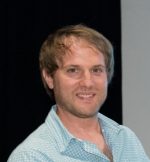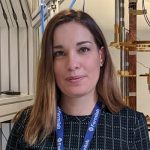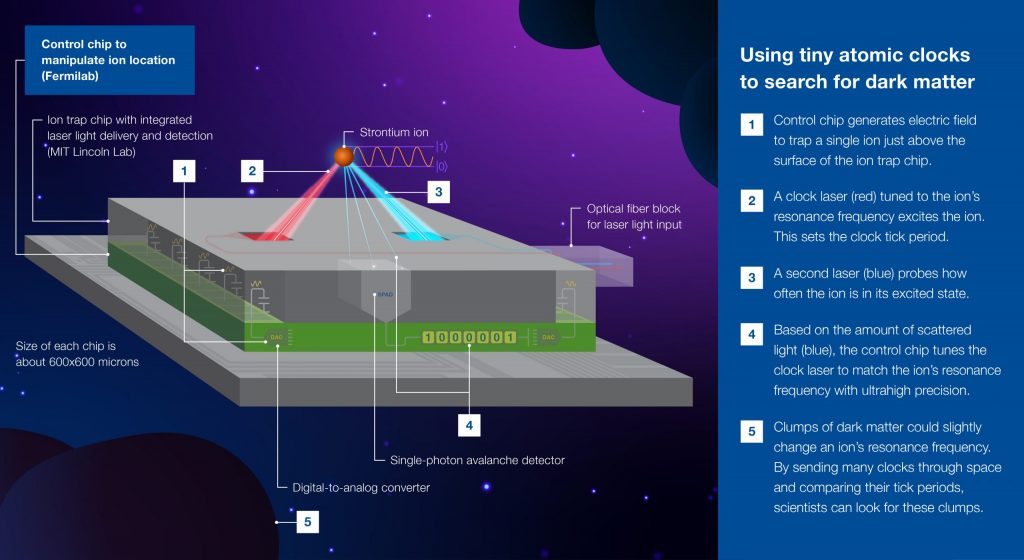The U.S. Department of Energy’s Fermi National Accelerator Laboratory hosted an event today to kick off the U.S. Quantum Information Science School, one of the largest federally sponsored education programs to help build a quantum-ready workforce.
“The Quantum Information Science School is a unique program that will extend the amazing opportunities of this emerging field to a diverse group of participants—a top priority for the Department of Energy,” said Asmeret Asefaw Berhe, DOE’s director of the Office of Science. “Programs like this strengthen and advance the U.S. science and technology enterprise by broadening participation of people from all walks of life in STEM fields and ensuring equitable access to the benefits of new and emerging technologies and scientific innovation.”
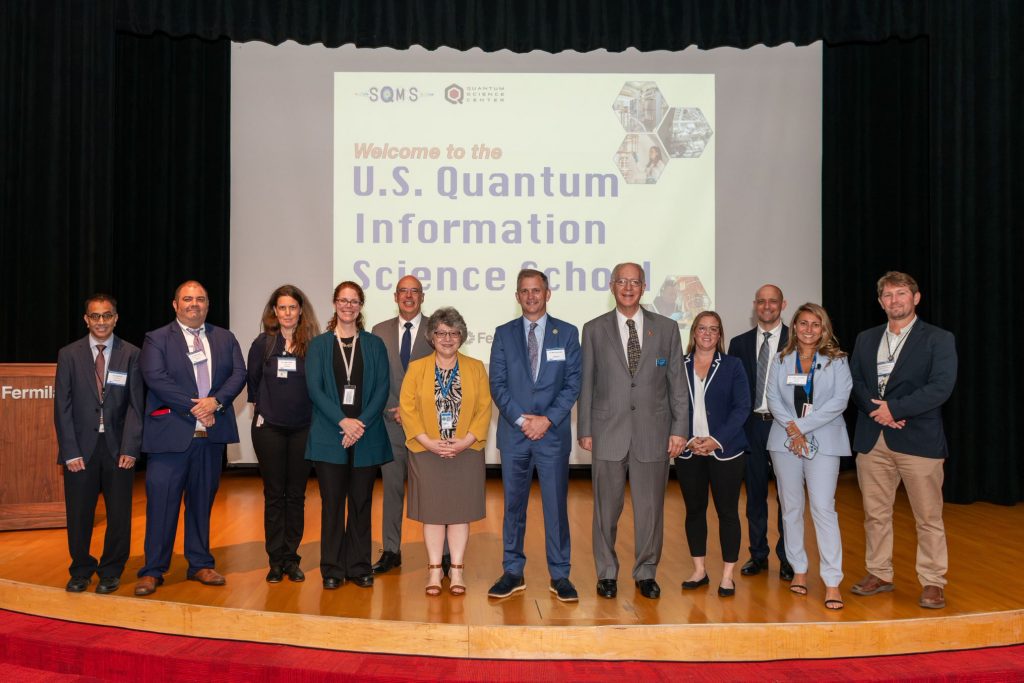
Delegates from the U.S. Department of Energy, White House Office of Science and Technology Policy, Fermilab Directorate, U.S. Congress and leadership from the National Quantum Information Science Research Centers inaugurated the first USQIS school on Aug. 7. Photo: Ryan Postel, Fermilab
As part of the inauguration for the first QIS program session, participants heard from notable guests, including Charles Tahan, the assistant director of quantum information science from the White House Office of Science and Technology Policy; U.S. Reps. Sean Casten (Ill.) and Bill Foster (Ill.); Fermilab Director Lia Merminga; SQMS and QSC Centers’ Directors Anna Grassellino and Travis Humble; and welcoming remarks from Berhe, who attended the event virtually.
The school’s organization is led by the Fermilab-hosted SQMS Center, in collaboration with the Quantum Science Center, hosted by DOE’s Oak Ridge National Laboratory, and draws on experts from all five DOE Office of Science Quantum Research Centers. Each of the five is comprised of national lab, academic and industry collaborators, ensuring a nation-wide effort to advance quantum information science and technology. The school, mirroring the structure of the five centers, unites experts, beyond-the-state-of-the-art facilities and the next generation of the quantum workforce.
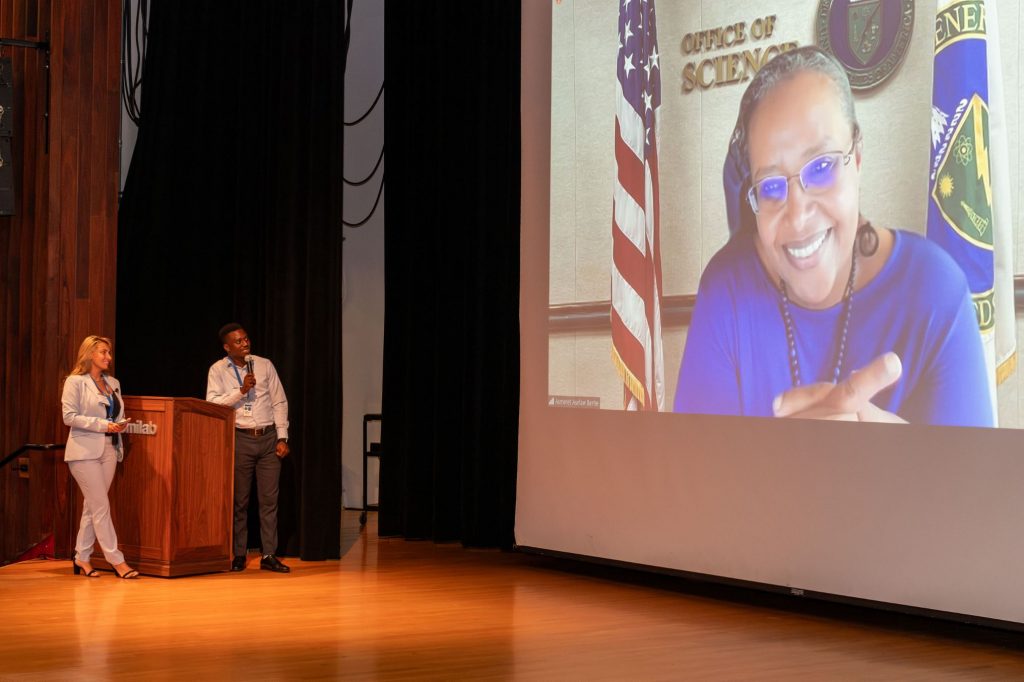
Oluwadara Ogunkoya (middle left), the SQMS Center Carolyn B. Parker fellow, asks Asmeret Asefaw Berhe, director of the DOE Office of Science, why is quantum information science important for the DOE Office of Science. Photo: Ryan Postel, Fermilab
“Illinois is a global leader in quantum research, advancement and commercialization, with the opening of the first U.S. Quantum Information Science School putting us one step closer to transforming the way so many of our sectors operate,” said Illinois Gov. J.B. Pritzker. “We’re proud to be the state with the highest quantum investment and the most centers in the United States, and this program will keep us at the forefront. Our top asset has always been our people—this new, innovative opportunity will keep preparing our top-tier workforce for the jobs and challenges of the future.”
Nearly 150 students from across 70 institutions will spend 10 days at Fermilab building theoretical knowledge and practical experimental skills in the field of quantum information science. The participants represent a broad range of experience and backgrounds, including undergraduate and graduate students from across the U.S., educators, federal labs and industry professionals.
The USQIS school is structured to host morning lectures by world-leading experts in QIS, followed by afternoon sessions where participants dive deeper into the subject matter using SQMS Center laboratories and equipment. The program will cover a range of topics in QIS, including quantum device controls and measurements; quantum computing algorithms; quantum sensing; quantum device design and fabrication; cryogenics; and material science. Beyond the coursework and lab time, multiple panel discussions, poster sessions and networking opportunities will enrich the USQIS school.
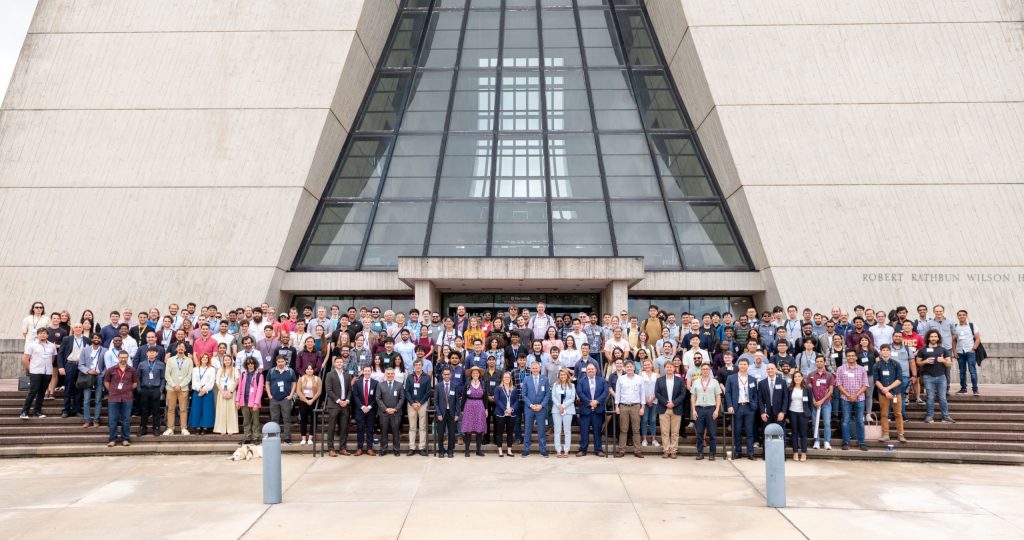
Students from the USQIS school and notable guests gathered outside of Fermilab’s Wilson Hall on Aug. 7. Photo: Ryan Postel, Fermilab
“With the new USQIS school, we want to offer an education program that gives an opportunity to engage in 360-degree, interactive, hands-on learning, the likes of which is currently out of reach for many who are interested in the rapidly expanding field,” said Grassellino. “These technologically advanced and sophisticated facilities are not widely available, and we believe that the DOE centers are the right place to serve as the training ground for the future generation of quantum scientists, engineers and supporting roles.”
Students will have access to qubits, quantum devices and platforms at the SQMS Center, developed by Fermilab, the National Institute of Standards and Technology and Rigetti Computing. The classes are taught by experts from Fermilab, Northwestern University, Ames, Los Alamos and Oak Ridge National Laboratories, Louisiana State University, Michigan State University, Massachusetts Institute of Technology, IBM, NIST, NASA Ames, Rigetti Computing and more. By combining the expertise of DOE national laboratories, academia and the private sector, the program aims to create and steward the ecosystem needed to foster and facilitate the advancement of QIS. The anticipated national impact is on national security, economic competitiveness and America’s continued leadership in science and technology.
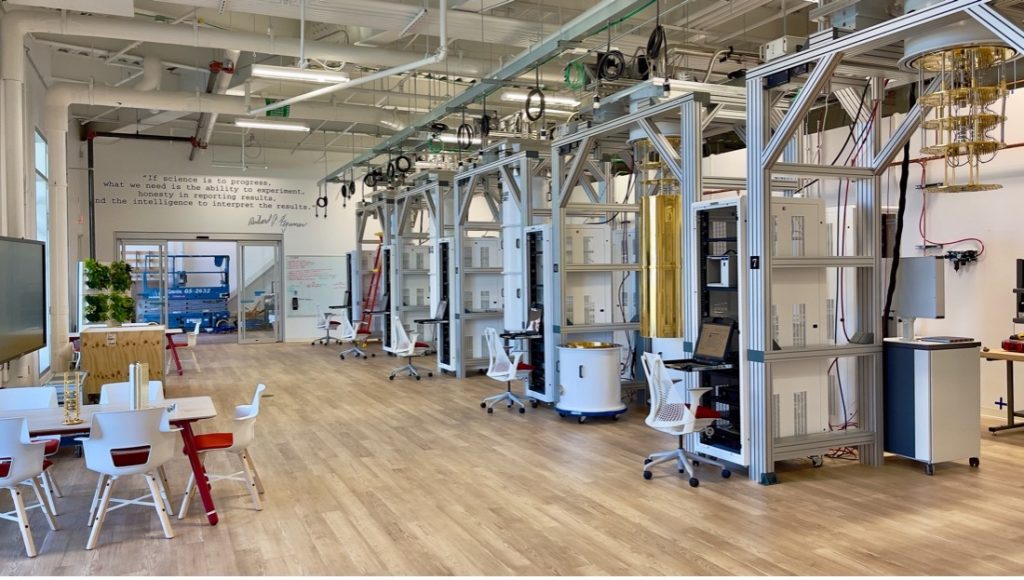
The new SQMS laboratory at Fermilab where students attending the USQIS school will engage with quantum professionals during the 10-day program. Photo: Fermilab
The program is part of a national effort set forth by the National Quantum Initiative Act, which allocated more than $1 billion dollars for research in artificial intelligence and quantum information science. Under this act, Congress established five unique National Quantum Information Science Research Centers that are hosted by their respective DOE national laboratories.
Each of these centers leverage the core capabilities and strengths of their host laboratories to investigate ways to advance the field of quantum information science. Researchers aim to harness quantum mechanics to perform computations that would be practically impossible for classical computers and to create ultra-sensitive detectors.
“This week, participants will get a firsthand look at the most cutting-edge science and technology,” said Tahan. “Efforts to educate the next quantum workforce are essential in meeting the nation’s growing demands for viable quantum technologies.”
The Superconducting Quantum Materials and Systems Center at Fermilab is supported by the DOE Office of Science.
The Superconducting Quantum Materials and Systems Center is one of the five U.S. Department of Energy National Quantum Information Science Research Centers. Led by Fermi National Accelerator Laboratory, SQMS is a collaboration of 30 partner institutions—national labs, academia and industry—working together to bring transformational advances in the field of quantum information science. The center leverages Fermilab’s expertise in building complex particle accelerators to engineer multiqubit quantum processor platforms based on state-of-the-art qubits and superconducting technologies. Working hand in hand with embedded industry partners, SQMS will build a quantum computer and new quantum sensors at Fermilab, which will open unprecedented computational opportunities. For more information, please visit sqmscenter.fnal.gov.
Fermilab is supported by the Office of Science of the U.S. Department of Energy. The Office of Science is the single largest supporter of basic research in the physical sciences in the United States and is working to address some of the most pressing challenges of our time. For more information, visit science.energy.gov.
The U.S. Department of Energy’s Office of Science has selected two DOE Fermi National Accelerator Laboratory scientists to receive the 2023 DOE Early Career Research Award, now in its 14th year. The prestigious award is designed to bolster the nation’s scientific workforce by providing support to exceptional researchers at the outset of their careers when many scientists do their most formative work.
This year, 93 early career scientists representing 47 universities and 12 national laboratories in 27 different states across the country have been selected to receive funding as part of DOE’s Early Career Research Program. These awards are a part of the DOE’s long-standing efforts to develop the next generation of STEM leaders.
“Supporting America’s scientists and researchers early in their careers will ensure the United States remains at the forefront of scientific discovery,” said U.S. Secretary of Energy Jennifer M. Granholm. “The funding announced today gives the recipients the resources to find the answers to some of the most complex questions as they establish themselves as experts in their fields.”
To be eligible for Early Career Research Program awards, a researcher must be an employee at a DOE national laboratory who received a doctorate within the past 12 years. Research topics must fall within the scope of one of the Office of Science’s eight major program areas, which includes high-energy physics. Outside scientific experts then select the awardees based on peer review.
The Fermilab recipients are:
Under the program, the Fermilab researchers will receive grants for more than $400,000 per year. The research grants are planned for up to five years and will cover salary and research expenses. Profiles on these individuals and their research will be published over the next few weeks.
Fermi National Accelerator Laboratory is supported by the Office of Science of the U.S. Department of Energy. The Office of Science is the single largest supporter of basic research in the physical sciences in the United States and is working to address some of the most pressing challenges of our time. For more information, please visit science.energy.gov.
In 2021, amid the COVID-19 pandemic, two instruments, each approximately the size of two refrigerators, arrived at the U.S. Department of Energy’s Fermi National Accelerator Laboratory in Batavia, Illinois. The first landed in March, the second in December.
They were amplifiers — the first prototype units of what will become the power source for Fermilab’s new linear particle accelerator. A team of scientists and engineers at India’s Raja Rammana Centre for Advanced Technology, or RRCAT, designed, developed and built both of them for the Proton Improvement Plan II, or PIP-II, project at Fermilab.
But with the pandemic restrictions on international travel, Indian scientists could not accompany their work to the United States. Instead, engineers at Fermilab had to install the amplifiers with guidance “over the phone,” said Jim Steimel, PIP-II sub-project manager for high-power radiofrequency at Fermilab. The tight cooperation between the teams ensured the successful installation, despite the challenges of remote coordination.
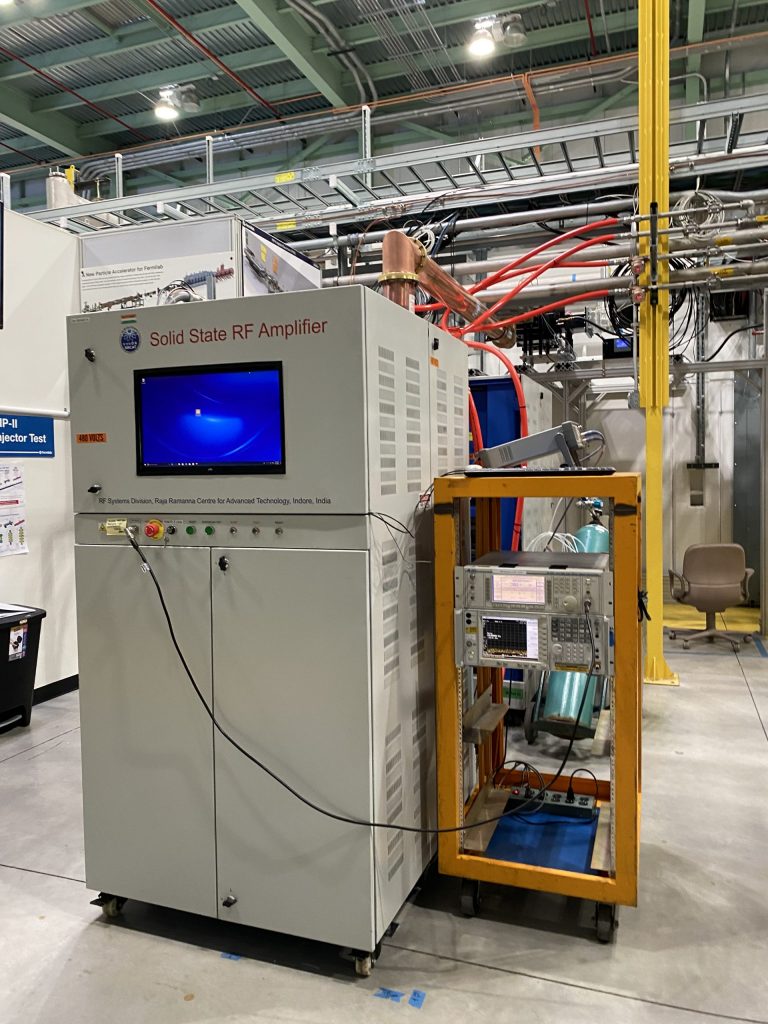
Scientists at RRCAT in India developed and built this prototype 40-kilowatt solid-state radiofrequency amplifier for PIP-II before shipping it to Fermilab for testing. Photo: Madeleine O’Keefe, Fermilab
It’s one example of the strong collaboration between the U.S. and India in high-energy physics and accelerator research. Now, with travel restrictions loosened, a few representatives from the Indian PIP-II team have made their way to Fermilab to — finally — see their work in action.
An important partnership
India is an important scientific partner for the United States. Recently, in mid-June, Prime Minister Narendra Modi of India and United States President Joe Biden met at the White House to deepen bilateral cooperation between the two countries on cutting-edge scientific infrastructure. As part of the agreement, India will supply components worth $140 million to the PIP-II project. This contribution was even highlighted in this White House statement (see number 10).
The Indian Department of Atomic Energy institutions have a strong partnership with Fermilab. In February 2023, DOE’s Asmeret Berhe took her maiden visit to India as the director of the Office of Science. Invited by the chairman and the secretary of DAE, Berhe participated in meetings with officials at the U.S. Embassy, as well as India’s Ministry of External Affairs, the Bhabha Atomic Research Centre and Tata Institute of Fundamental Research. The tour included a visit to the University of Chicago Delhi Center. She also met with institutional leaders who work on high-energy physics programs, with a specific emphasis on accelerator programs.
Accompanying Berhe on the visit was a cohort that included Gina Rameika, associate director for the DOE Office of High Energy Physics; Lia Merminga, Fermilab director; Josh Inaba, special assistant, Office of Science; Daniel Schwab, science and technology policy advisor, Office of International Science and Tech Cooperation and Trusted Research, Office of Science; and Hema Ramamoorthi, Fermilab director for international engagements.
PIP-II is the first particle accelerator to be built in the U.S. with significant contributions from international partners. In addition to India, the PIP-II project will receive in-kind contributions from institutions in France, Italy, Poland and the United Kingdom. India’s deliverables include superconducting acceleration structures, electromagnets and radio-frequency power sources that will be fabricated in India and then transported to the U.S. for installation.
Pioneering new technology with PIP-II
PIP-II’s new accelerator will power the world’s most intense beam of neutrinos. It will provide the beam for the Deep Underground Neutrino Experiment, hosted by Fermilab. Over the course of its 215-meter length, the accelerator will drive particles to nearly 85% the speed of light through five different types of accelerating cryomodules.
The linear accelerator uses superconducting radio-frequency technologies to power the particle beam. SRF technologies enable much more efficient particle acceleration than conventional technologies; however, they also require ultracold temperatures to operate. So, the cryomodules house strings of cavities — ranging from three to eight — in liquid helium baths and layers of insulation that isolate the cavities from the “warm” room temperature. PIP-II has 116 cavities distributed among 23 cryomodules.
“I think it is important that they are able to visit the laboratory and see their product in action.” – Jim Steimel, PIP-II sub-project manager for high-power radiofrequency at Fermilab
PIP-II uses five different types of SRF cavities, with each type designed to efficiently accelerate particles of a particular velocity. “Every cavity requires a radiofrequency source to accelerate the beam,” said Steimel. The power to maintain the beam varies based on the cavity.
PIP-II uses three different radio frequencies to power the beam. As the beam gets narrower farther down the accelerator, they use shorter-wavelength frequencies to compress the beam further.
“We need to generate the RF necessary to keep the field in those cavities,” said Steimel.
So the accelerator uses amplifiers that magnify the radiofrequency signal and send it into the cavities. Different amplifiers operate at 7 kilowatts for the first stage of acceleration, 20 kilowatts for the second, 40 kilowatts for the third and up to 70 kilowatts for the final stage. Engineers designed these amplifiers based on solid-state RF amplifier technology, or SSAs.
Making valuable contributions
Institutions in India will supply all the hardware for the SRF cavity amplifiers. The Bhabha Atomic Research Centre in Mumbai will provide amplifiers for the lower-energy single-spoke resonator cryomodules. So far, they have sent nine 325-megahertz 7-kilowatt amplifiers, which Fermilab tested in beam operations.
Meanwhile, RRCAT will provide amplifiers for the 650-megahertz cryomodules: 36 of the 40-kilowatt and 24 of the 70-kilowatt types. The amplifiers sent during the pandemic were prototypes of a 32-kilowatt and 40-kilowatt amplifier to be used for testing. (PIP-II will not use a 32-kilowatt amplifier in the accelerator, but it was sent as a prototype for proof of concept.)
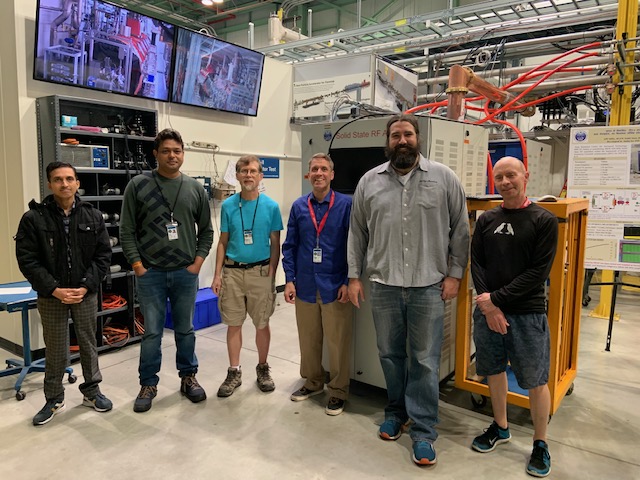
From left to right: Deepak Sharma and Alok Gupta (both from RRCAT), David Peterson, James Steimel, Victor Grzelak and Patrick Sheahan (from Fermilab) stand in front of the prototype 40-kilowatt amplifier for Fermilab’s PIP-II particle accelerator. Photo: Niral Patel, Fermilab
Each amplifier is made up of dozens to hundreds of 500-watt amplifier modules, called power amplifiers, or PAs. The large magnitude of modules required for assembly—ranging from 96 to 232 PAs per amplifier—make the amplifiers extremely complex.
“RF amplifiers are really delicate and complex equipment. After commissioning in PIP-II, they will be operated for 20 years,” said Deepak Sharma, a scientific officer at RRCAT. “So, this is a highly important task for both institutions.”
Sharma is one of the two Indian scientists visiting Fermilab to work on the amplifiers. He arrived in early May, overlapping with fellow RRCAT scientific officer Alok Gupta who arrived in February and departed mid-May. Sharma’s stay will last approximately three months. It is the first visit to the United States for the scientists, both of whom were on the RRCAT team that developed the amplifiers in India.
“I think it is important that they are able to visit the laboratory and see their product in action,” says Steimel. “They’re seeing how this is actually working in operation: They’re watching the operators using it, trying to keep the field up in the cavities. They’re getting feedback from the people that are operating it in terms of possible issues with control and stability.”
The prototype 32-kilowatt amplifier initially encountered some issues during testing. So, Gupta set up a test stand to measure, qualify and repair the PAs for 650-megahertz SSAs. After two months of work with Fermilab engineers, Gupta reported the amplifier now functions reliably.
Sharma has continued working on improving the amplifier design while on site. He and Gupta will take those improvements and bring them back to RRCAT to be considered for the next set of designs based on updated requirement specifications. “These improvements will be incorporated in final sets of the amplifiers as prototype amplifiers were based upon earlier requirements,” said Gupta. “So, we will be working on the newer designs at our lab at RRCAT.”
The RRCAT team is currently prototyping improved amplifier subsystems for PIP-II. The final design review for the 40-kilowatt amplifier is tentatively scheduled for September; in the meantime, RRCAT will conduct their own internal reviews.
In a few years, when the PIP-II team is ready to assemble the entire accelerator, Gupta and Sharma hope to return to Fermilab with their team to install their amplifiers — in person, this time.
Fermi National Accelerator Laboratory is supported by the Office of Science of the U.S. Department of Energy. The Office of Science is the single largest supporter of basic research in the physical sciences in the United States and is working to address some of the most pressing challenges of our time. For more information, please visit science.energy.gov.
In the search for dark matter — the mysterious, invisible substance that makes up more than 80% of matter in our universe — scientists and engineers are turning to a new ultra-sensitive tool: the optical atomic clock.
These clocks, which measure time by using an ultra-stable laser to monitor the resonant frequency of atoms, are now precise enough that if they ran for the age of the universe, they would lose less than one second. That stability also enables these devices to act as extremely sensitive quantum sensors that could be deployed into space to search for dark matter.
The challenge: The equipment required to operate such ultra-precise clocks — including lasers, electronics and coolers — can fill a large table or even a room. It would make launching them into space very expensive if not impossible.
Scientists working on a joint U.S. Department of Energy and Department of Defense project aim to miniaturize these elements to the size of a shoebox. After more than two years of work, the researchers — from the DOE’s Fermi National Accelerator Laboratory and the Massachusetts Institute of Technology Lincoln Laboratory — have reported initial promising results.
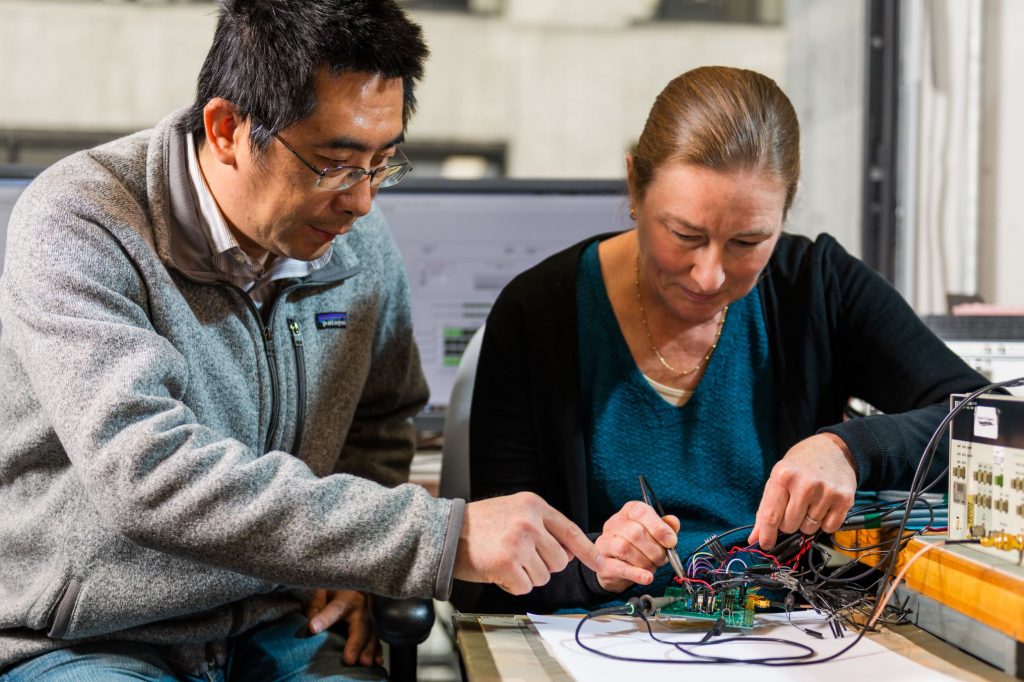
Fermilab researchers Hongzhi Sun and Pamela Klabbers test the chip at the test stand. Photo: Ryan Postel, Fermilab
Fermilab researchers designed and developed the compact electronics needed to control the voltages within the device, while MIT LL researchers are developing the tiny ion traps and corresponding photonics needed to build the clock. The chip designed by the Fermilab team is currently under testing at MIT LL.
“This is the first step toward a high-accuracy, small footprint atomic clock,” said Fermilab Microelectronics Division Director Farah Fahim, who leads the project for the lab.
A new way to detect dark matter
MIT LL’s optical atomic clock uses an ion trap as a sensor — in this case, a Strontium ion that is confined by an electrical field. A laser acts as the clock’s oscillator, measuring the oscillation frequency of the ion’s transition between two quantized energy levels.
This sort of compact atomic clock could be ideal for deployment to space to search for ultralight dark matter, which is theorized to cause oscillations in the masses of electrons. If several atomic clocks traveled through a clump of dark matter in space, the dark matter could increase or decrease the photon energy measured by each clock, changing how it “ticks.” The clocks would desynchronize as the dark matter passes and resynchronize thereafter.
Researchers conducted these experiments with GPS satellites, which each contain multiple atomic clocks based on a different technology. But they found no evidence for dark matter in these experiments. Perhaps, the researchers considered, dark matter could be detected with a more sensitive clock.
Funded by the DOD, MIT LL researchers have miniaturized the trapped-ion atomic clock, integrating laser delivery and detection all onto one chip. But to complete the system, MIT LL researchers needed more than just miniaturized atomic and photonic components. They needed help designing a miniature electronic control system. That’s where Fermilab came in; DOE’s high-energy physics QuantISED program funded the electronics development and integration.
“We have more than 30 years of experience developing compact electronics for collider physics, and we have developed chips for extreme environments,” Fahim said. “That’s not unlike the electronics needed for controlling atoms and reading out their state.”
“It’s a project that really leverages the unique capabilities of different government laboratories,” said Robert McConnell, staff scientist at MIT LL who led development of the photonic ion trap chip for the project.
Integrating compact electronics with the ion trap
The difficulty lies in creating a small chip that can control the high voltages needed for the system — at least 20 volts — while both retaining high speed and utilizing low power. Working with a semiconductor manufacturer, the Fermilab team recently created a chip that could control up to nine volts. “It also has low voltage noise, so it won’t perturb the quantum state of the ion,” said Hongzhi Sun, the lead chip designer on the project.
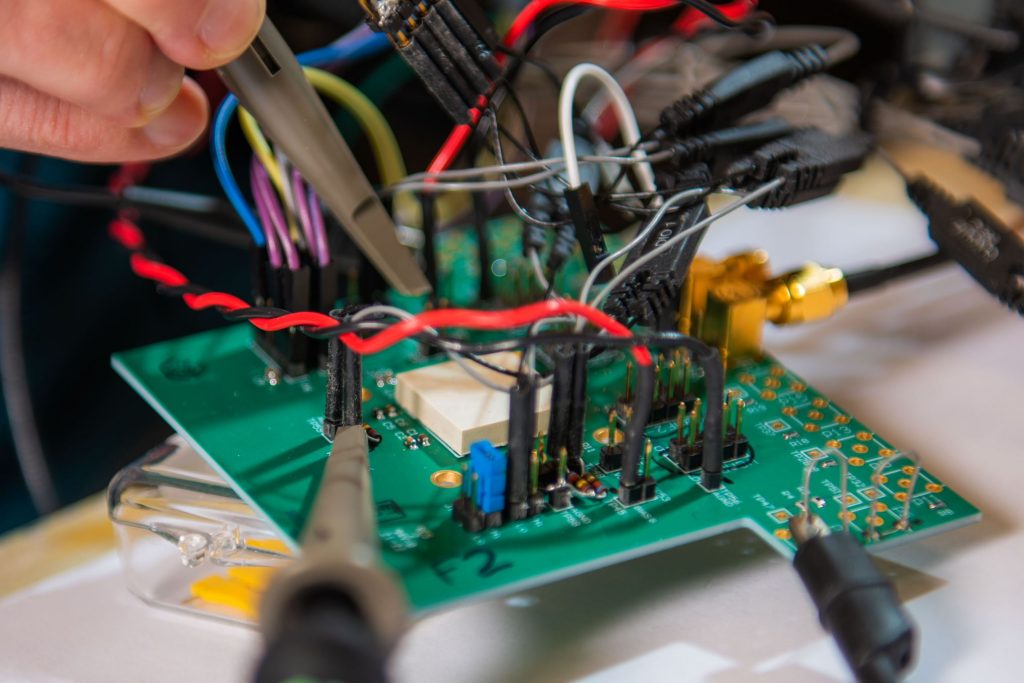
Ready for testing: The chip’s custom test board is connected the test equipment. The chip is wire-bonded to the board and protected by the square white plastic cap. Photo: Ryan Postel, Fermilab
MIT LL researchers now look to integrate the chip with the ion trap through a technique that allows them to stack the two chips on top of each other and connect them through vias, or electrical connections between layers. Fermilab researchers will then continue to hone the electronics design to increase the voltage up to 20 volts. The goal is to create a compact atomic clock with frequency uncertainty of 10-18.
Other applications
“This collaboration allows us the benefits of both worlds,” said McConnell. “By having Fermilab design circuits and integrating them with our ion traps, we can create well-controllable quantum sensors.”
The clocks could be used beyond high-energy physics research, including in space defense or even as extremely sensitive sensors that could predict tsunamis or earthquakes. These ion traps could also form the basis for future quantum computers.
“There is a great disparity in the application goals for DOD and DOE but an equally compelling synergy in the underlying technology development; we simply need to find ways to work together,” Fahim said.
Fermi National Accelerator Laboratory is supported by the Office of Science of the U.S. Department of Energy. The Office of Science is the single largest supporter of basic research in the physical sciences in the United States and is working to address some of the most pressing challenges of our time. For more information, please visit science.energy.gov.

